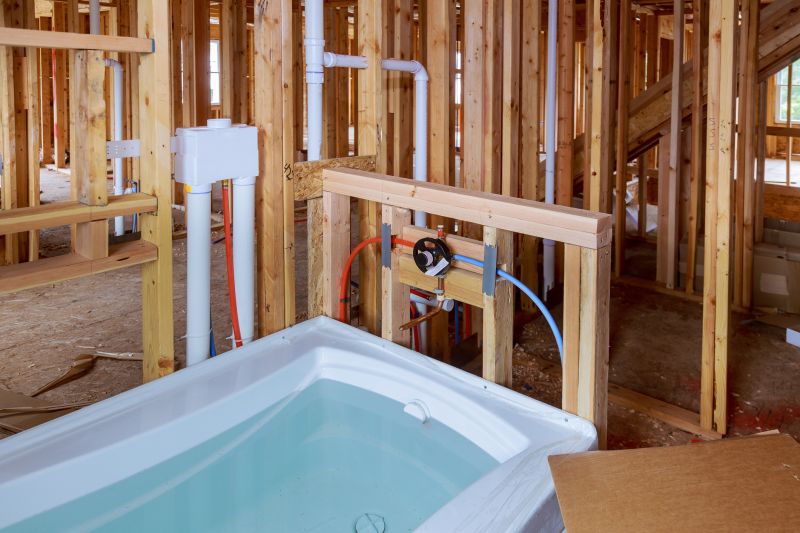Favorite Tools And Materials For Bathtub Installation Projects
Get access to essential tools and materials favored by installers for successful and hassle-free bathtub setups.
 Installing a bathtub is a common home improvement project that can significantly enhance the functionality and aesthetic appeal of a bathroom. Whether replacing an old tub or installing a new one in a renovated space, choosing the right products is essential for ensuring durability, safety, and ease of installation. The process often involves selecting appropriate fixtures, surrounds, and support systems that fit the specific dimensions and style preferences of the homeowner.
Installing a bathtub is a common home improvement project that can significantly enhance the functionality and aesthetic appeal of a bathroom. Whether replacing an old tub or installing a new one in a renovated space, choosing the right products is essential for ensuring durability, safety, and ease of installation. The process often involves selecting appropriate fixtures, surrounds, and support systems that fit the specific dimensions and style preferences of the homeowner.
Top Overall Option
Durable Acrylic Bathtub
Acrylic bathtubs are widely favored for their versatility, ease of maintenance, and variety of design options. They are lightweight yet durable, providing a comfortable bathing experience. When choosing an acrylic tub, consider models that feature reinforced sides and non-slip surfaces for added safety. Proper installation involves compatible fixtures and sealants to ensure long-lasting performance and a watertight fit.
Types of Products For Bathtub Installations
Acrylic Bathtubs
Lightweight, versatile, and available in many styles, acrylic tubs are popular for both new installations and replacements.
Cast Iron Bathtubs
Known for their durability and classic appearance, cast iron tubs are heavy but long-lasting options.
Fiberglass Bathtubs
Affordable and easy to install, fiberglass tubs are common in many homes and renovations.
Composite Material Tubs
Made from a combination of materials, these tubs offer strength and a smooth finish.
Corner Bathtubs
Designed to fit into corner spaces, these tubs maximize bathroom area while providing a comfortable bathing experience.
Walk-in Tubs
Ideal for accessibility, these tubs feature doors for easy entry and exit.
Clawfoot Tubs
Vintage-style tubs that add character and charm to traditional bathroom designs.
Drop-in Tubs
Designed to be installed into a custom surround or deck, offering flexibility in design.
Undermount Tubs
Installed beneath the bathroom surface for a sleek, seamless look.
Soaking Tubs
Deeper and wider, these tubs are designed for relaxing baths and comfort.
Spa Tubs
Equipped with jets and features for a hydrotherapy experience.
Freestanding Tubs
Standalone units that serve as focal points and are easy to install in various bathroom layouts.
Alcove Tubs
Designed for installation in three-wall alcoves, common in standard bathrooms.
Vessel Tubs
Sit atop the floor and serve as a statement piece with their distinctive design.
Whirlpool Tubs
Feature multiple jets for a massage-like experience, suitable for relaxation.
Corner Jetted Tubs
Combine corner placement with jet features for space-saving comfort.
Convertible Tubs
Offer multi-functionality, such as combining shower and bath features.
Popular Choices
A common choice for many bathrooms due to their affordability and variety.
Preferred for their durability and classic look, often found in vintage-inspired bathrooms.
A budget-friendly option that is lightweight and easy to install.
Growing in popularity for accessibility and safety features.
Chosen for their aesthetic appeal and flexibility in placement.
Maximize space in smaller bathrooms while providing comfort.
Popular for modern and contemporary bathroom designs.
Flexible installation option that integrates well with custom surrounds.
Favored for relaxation and hydrotherapy features.
Standard choice for many built-in bathroom layouts.
Popular for sleek, modern aesthetics with seamless surfaces.
Adding vintage charm, these tubs remain a stylish option.
Bathtub installation products vary widely, from traditional acrylic units to more modern composite materials. Each type offers different benefits in terms of maintenance, comfort, and longevity. Proper installation also requires selecting compatible plumbing fixtures, sealants, and mounting hardware to create a watertight and secure fit. For those undertaking the project themselves, understanding the available options and their features can make the process smoother and more efficient.
When planning a bathtub installation, it is important to consider the existing bathroom layout and the space available. Some products are designed for retrofit projects, fitting into existing alcoves or spaces, while others may require modifications to the surrounding walls or flooring. Additionally, accessibility features such as grab bars or walk-in designs can be incorporated for enhanced safety and convenience. Ensuring that all components meet local building codes and manufacturer specifications is crucial for a successful installation.
In summary, selecting the right products for bathtub installation involves evaluating the type of tub, the supporting hardware, and the finishing accessories. Proper planning and informed choices can help achieve a functional and attractive bathroom setup that meets individual needs and preferences. Consulting with professionals or experienced DIYers can also provide valuable insights into the best products and installation techniques for your specific project in Roseville, MI.
Key Buying Considerations
- Material durability and maintenance requirements
- Size and dimensions to fit your bathroom space
- Installation type and compatibility with existing plumbing
- Weight of the tub and floor support needs
- Design style and aesthetic preferences
- Accessibility features such as low thresholds or built-in grab bars
- Surround and finishing options for a cohesive look
- Availability of warranty and customer support
- Ease of cleaning and surface finish
- Cost and budget constraints
- Energy efficiency and water consumption
- Compatibility with existing fixtures and hardware
- Local building codes and installation regulations
- Resale value and overall bathroom design harmony
- Additional features like jets or built-in storage
